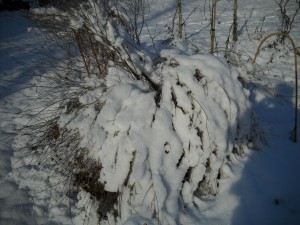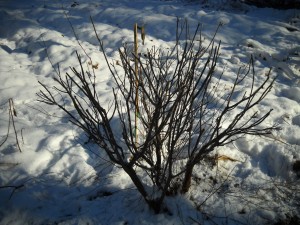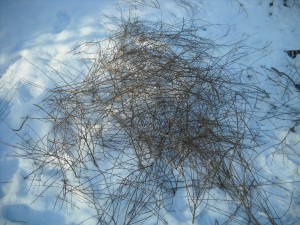Protect Your Shrubs from Winter Breakage
I’ve had a nice little dwarf willow for 15 years or more, and this summer I noticed it was getting to be bigger than I wanted it to be. But summers are busy and I didn’t prune it. Fall came along; I did some traveling, and still didn’t prune it. But last week I went outside on a nice sunny day and gave it a serious haircut.
The arctic blue willow is very slow growing – it’s a variety with the final word ‘nana’ attached to its Latin name (Salix purpurea ‘nana’) , indicating that it is a shrub or tree that stays small. I had only pruned it once or twice in its lifetime, and it had gotten to be 6 feet tall. The branches had branched and re-branched so many times that they held snow like a woven basket. When we got an inch or two of snow the branches were doubled over and looked ready to break. I knew I had to take action before the heavy snows of winter came.
The first thing I did was to give the branches a good shake to rid them of snow, and lifted them back into their proper shape. It rebounded immediately. Then I looked for any broken or dead branches but saw none. This is a good healthy little tree.
Each pruning job is different. The Arctic blue willow tends, by its nature, to stay very compact. It has lots of handsome small leaves with a slightly bluish caste. The branches fork and divide, creating lots of very fine twigs near the tips of the branches. What I needed to do – in order to protect it from winter breakage – was to remove the finest branches, those near the tip of each branch.
Instead of just removing the tips of the branches, however, I followed fine branches back to bigger branches, and removed some of those bigger branches – thus taking off several fine branches with each cut. I staggered my cuts, much as a hair stylist might create a layered look with your hair. Some branches lost just a few inches, others were cut back by 2 feet.
Overall, I reduced the height of the plant from 6 feet to about 4 feet and made the interior of it open and airy. Come spring, the willow will grow new shoots at most places where it was cut. It may send out two to three shoots where one was cut off. So I will have my pruners ready to tune it up next fall if I need to.
Before you prune a tree or shrub in winter it’s good to know when its season of bloom occurs. I grow that willow for its shape and foliage, not blossoms– there are small catkins in the spring, but those are barely noticeable. By pruning it hard, as I did, there will be no blooms next spring because I removed most or all of the buds. But the lack of blooms is of no importance to me.
If you have a tree or shrub that blooms nicely in the spring (such as forsythia, lilac or common ninebark) you may want to consider putting off pruning until after bloom time. However, if you notice that early ice and snow is bending the branches and weighting them down, some judicious pruning now can help the plant. If snow or ice does your pruning for you, the bark will tear, opening up sites where disease or insects can enter.
Late summer blooming shrubs can be pruned now with no loss of flowers next year. Plants like the common ‘peegee’ hydrangeas set flower buds on new growth, not growth that occurred the summer before. In fact, if you have not cut off this year’s flower panicles (and some of their stems yet) from your peegee hydrangea, you should do so now. They will be weighted down by snow and may break.
Whenever you prune a tree or shrub you should remove any dead branches first. You can tell a dead branch from a live one in winter by using your thumbnail to scratch the surface of the bark. If you see green, it is alive; if it’s brown, it’s dead. With a little practice, you’ll recognize dead branches on sight.
If you see two branches that are crossing or rubbing, get out your pruners. Rubbing branches wear off bark, opening wounds – so get rid of one (or both, if they are already damaged). Crossing branches may not be rubbing now, but they will as they get bigger or covered with snow.
Good questions to ask yourself when pruning are these: what is the potential of this branch? What will it be like in 5 years? A branch that travels through the center of a shrub has no potential – it will soon be rubbing against other branches. And it’s always better to clean out messy branches when they are small.
Pruning can be functional: it minimizes damage and keeps trees and shrubs to manageable size. But pruning is also an art. You can sculpt your trees and shrubs so that they are works of art as you look out over your winter landscape. Have at it!
Henry Homeyer’s Web site is www.Gardening-guy.com. He is the author of 4 gardening books.






